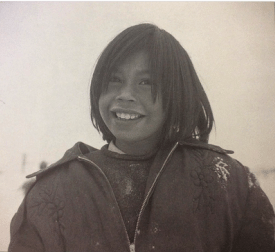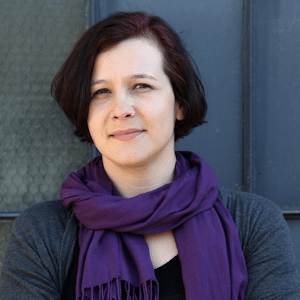
(Lynn Scurfield)
Daniel Heath Justice
The Vancouver author and scholar counters the misconception there aren’t enough indigenous writers worth celebrating
Daniel Heath Justice was frustrated. The University of British Columbia professor was tired of being told there wasn’t enough indigenous literature in the world to warrant its studying or teaching of, or enough works produced to even consider indigenous writing a proper literary tradition. “I knew that wasn’t the case,” he says. “I knew that there were ample people.”
Born and raised in Colorado, Justice is a citizen of the Cherokee Nation in Oklahoma (he is now a Canadian citizen), and a fantasy writer who currently holds the Canada Research Chair in Indigenous Literature and Expressive Culture. He doesn’t remember exactly what sparked his decision to take action over his frustrations. But on Dec. 31, 2015, he started posting the name of one indigenous author to Twitter each day. A few people began retweeting his posts, encouraging him to continue, and then, scholar, author, and musician Leanne Betasamosake Simpson came up with the hashtag #HonouringIndigenousWriters. That’s when, Justice says, the project really took off. “I didn’t know what a hashtag was or how to use it,” he says. “I wasn’t entirely new to Twitter, but I didn’t have much facility with it.”
Within two weeks of launching the initiative, Justice had compiled a list for a year’s worth of tweets of indigenous author names from around the world, some found in anthologies from his own bookshelf, others submitted by people following the hashtag. “It really was a collective effort,” he says. “It caught fire and a lot of people contributed names to it, and a lot of people contributed energy, and it’s taken a life of its own.”
Justice purposely excluded many of the recognizable, bestselling authors one would expect to see on such a list. “I really wanted to show the breadth internationally of indigenous writers,” he says. “The big names always get all the attention and so many amazing writers just don’t get the public profile they deserve” – an ongoing issue that has come to the forefront with the controversy over Joseph Boyden’s heritage and his role as a spokesperson for the community. “I wanted to push against that,” says Justice. “There are a lot of people doing great work, busting genres, giving attention to their communities, speaking to a wide range of audiences. Some are working with various small, community-based publishers, or publishing works on their own. Some are trying to do as much in their language as they can because they’re committed to keeping their languages alive.”
One of the unexpected aspects of the project for Justice was discovering writers he hadn’t read before, such as Alaskan authors Fred Bigjim and Velma Wallace, and Australian novelist Kim Scott. In particular, he was amazed by the number of poets he was introduced to, such as Tommy Pico, a queer writer from Brooklyn whose work was recently praised in a New Yorker profile. “Some of these authors, I was ashamed I didn’t know them,” says Justice. “It was a revelation for me – it was super-exciting.” He also included writers from as far back as the 19th century to show the legacy of indigenous writing. “We’ve always been producing intellectuals both within and beyond the colonial system.”
One year, and 366 tweets later, Justice has wrapped up the project, but he hopes it will continue in other forms. He talks about putting all the names on a poster as a fundraiser for the Indigenous Literary Studies Association, and plans on including the list as an appendix in his next book. He also hopes others will pick up the momentum and start their own lists of indigenous works and scholars.
“One of the narratives about indigenous people is that we’re absent in history and in culture, and I think one of the things that the Twitter list does is show the opposite – that we have a really rich and robust presence,” says Justice. “We have people who are achieving really astonishing things in a whole range of areas, and have been doing it for many years.” – Sue Carter

(Lynn Scurfield)
Katherena Vermette
The Métis poet used filmmaking and Instagram storytelling to draw attention to the strength of the indigenous community and to keep her brother’s memory alive
Katherena Vermette was a teenager when her brother, Donovan, went missing in 1991. His body was found six months later, a heart-wrenching loss Vermette wrote about in her 2012 poetry collection, North End Love Songs (The Muses’ Company), which won a 2013 Governor General’s Literary Award.
After reading the collection, Alicia Smith, a National Film Board producer, contacted Vermette about making a documentary. Their collaboration, together with filmmaker Erika MacPherson, resulted in the short film this river, which premiered at the Montreal First Peoples Festival last August, winning the Coup de cœur du jury award. (It’s now available online via CBC and the NFB.)
Vermette, who began her career as an early childhood educator and picture-book author, comes from the Métis Treaty One territory in Winnipeg. Her debut novel, The Break, published by House of Anansi Press, about a crime in Winnipeg’s North End and its impact on those connected to the victim, was released last fall. Notwithstanding the success of her novel, Vermette says her writing flows most naturally through poetry. The title sequence for this river is a stanza from one of her poems: “indians drown/ the family finds out / happens everyday / this land floods / with dead indians / this river swells/ freezes / breaks open / cold arms of ice / welcomes indians.” She says writing and co-directing the documentary was a way to keep telling the story of her missing brother: “The film looks at how people go through trauma, and stretch themselves out from it to find ways to make the world a better place.”
In the film, Vermette accompanies Kyle Kematch, a volunteer from Drag the Red – an organization that combs the Red River for clues about missing members of indigenous communities – on a search. They talk about Vermette’s brother and Kematch’s missing sister, and explore the emotional experiences of loss. “Kematch does amazing work out of his pain, and in the indigenous community, giving back to find solace and ease through helping,” says Vermette.
Vermette further documented these efforts by writing for What Brings Us Here, the NFB-produced Instagram storytelling project associated with this river. “We wanted to look at the other volunteers in Drag the Red, and also [community-patrol organization] Bear Clan, Red Rising magazine, and all these other amazing things people are doing to highlight the strength and resilience of the community,” Vermette says. Although What Brings Us Here is currently on a production break, its following continues to grow. Vermette believes the initiative could be expanded to include more organizations in Winnipeg and across Canada in the future.
“It’s a devastating thing to lose someone, but I didn’t want to tell just that story, because it happened 25 years ago, and unfortunately it’s not unique,” says Vermette. – Suzanne Alyssa Andrew

(Lynn Scurfield)
Gregory Scofield
The award-winning poet transformed his Twitter account into a home to honour missing indigenous girls, women, and two-spirit people
In 2012, the poet Gregory Scofield’s partner convinced him to sign up for Twitter. Scofield, a Red River Métis of Cree, Scottish, and European descent, had always resisted social media. Twitter and Facebook were for other people, he thought, and he “didn’t want to be adding to the non-stop news and dialogue. Although that’s wonderful, I didn’t want to be one of those voices, sounding off on various issues.” Scofield wanted his account to have purpose, so he dedicated his online activity to missing indigenous girls, women, and two-spirit people (aboriginals identifying as part of the LGBTQ community).
Every day, Scofield posts a photo of a missing sister under the label “Name a Day,” along with her name and place of residence, and the hashtag #MMIW (missing and murdered indigenous women and girls). “It wasn’t just about raising awareness, it was also serving as a public-service announcement. … It was a chance to put their photographs out there, their names,” he says. “It was creating awareness but in the hopes that people would be able to help. The other part was using that space to honour the women who had been taken.”
For anyone unconvinced of the enormity and urgency of this crisis, scrolling through Scofield’s feed serves as a brutal eye-opener. There are girls as young as 10 years old, and women in their 60s. Many of the missing are teenagers. To help boost the number of people seeing the photos, Scofield recruited CBC Radio host Shelagh Rogers and Métis visual artist Christi Belcourt to retweet his posts. He has also recently started including the Twitter handle for Walking With Our Sisters, a volunteer group that created a travelling exhibition of more than 1,800 moccasin tops that honour the lives of missing and murdered indigenous women and girls (Scofield is on the organizing committee.)
Scofield, who currently works as an assistant professor of English at Laurentian University, has personal reasons for carrying on Name a Day. He has been an active advocate for women since 1998, when his aunt, Georgina Houle Young, was murdered, her killer never brought to justice. Scofield’s 2016 collection, Witness, I Am (Nightwood Editions), examines the crisis from a personal perspective while serving as another means of advocacy and hope for healing.
Currently Scofield doesn’t have any additional plans to change or expand Name a Day. “I’m happy people are following and, above all, people are retweeting and utilizing social media this way.” – Sue Carter



 Contact us via email
Contact us via email
